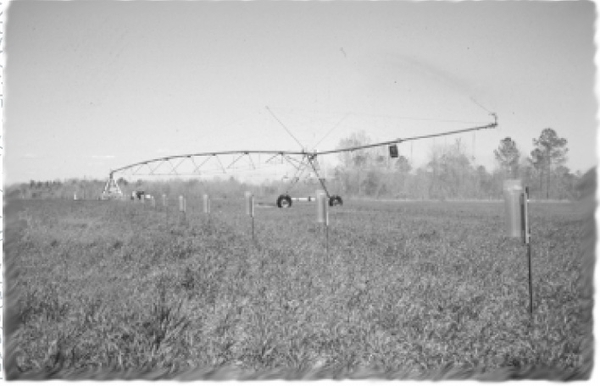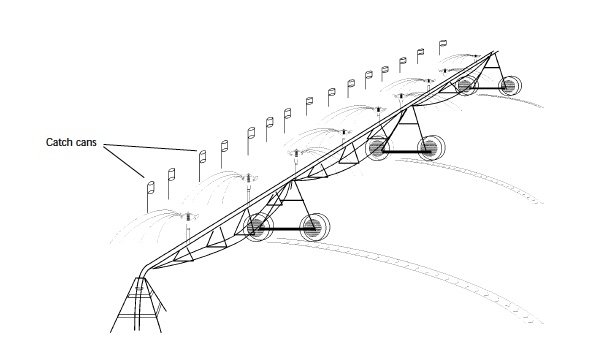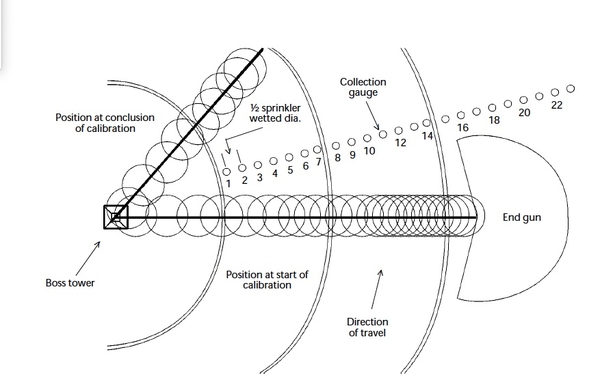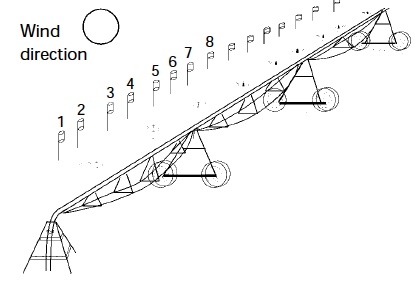Land application equipment used on animal production farms must be field calibrated or evaluated in accordance with existing design charts and tables according to state rules that went into effect September 1, 1996. Technical Specialist certifying waste management plans after September 1, 1996, must also certify that operators have been provided calibration and adjustment guidance for all land application equipment. The rules apply to irrigation systems as well as all other types of liquid, slurry, or solid application equipment.
Information presented in manufacturers’ charts are based on average operating conditions for relatively new equipment. Discharge rates and application rates change over time as equipment ages and components wear. As a result, equipment should be field calibrated regularly to ensure that application rates and uniformity are consistent with values used during the system design and given in manufacturers’ specifications. Field calibration involves collection and measurement of the material being applied at several locations in the application area. This publication contains step-by-step guidelines for field calibration of center pivot and linear move irrigation systems.
General Guidelines
Operating an irrigation system differently than assumed in the design will alter the application rate, uniformity of coverage, and subsequently the application uniformity. Operating with excessive pressure results in smaller droplets, greater potential for drift, and accelerates wear of the sprinkler nozzle. Pump wear tends to reduce operating pressure and flow.
With continued use, nozzle wear results in an increase in the nozzle opening, which will increase the discharge rate while decreasing the wetted diameter. Clogging of nozzles or crystallization of main lines can result in increased pump pressure but reduced flow at the sprinkler. Plugged intakes will reduce operating pressure. An operating pressure below design pressure greatly reduces the coverage diameter and application uniformity. Field calibration helps ensure that nutrients from animal waste are applied uniformly and at proper rates.
The calibration of a center pivot and linear move irrigation systems involves setting out collection containers, operating the system, measuring the amount of wastewater collected in each container, then computing the average application volume and application uniformity.
An in-line flow meter installed in the main irrigation line provides a good estimate of the total volume pumped from the lagoon during each irrigation cycle. The average application depth can be determined by dividing the pumped volume by the application area. The average application depth is computed from the formula:
\(\mathrm{Average\ application\ depth\ (inches)\ =\ }\frac{Volume\ pumped\ (gallons)}{27,154\ (gal/ac-in)\ \times\ Application\ area\ (acres)}\)
The average application depth is the average amount applied throughout the field. Unfortunately, sprinklers do not apply the same depth of water throughout their wetted area. Under normal operating conditions, application depth decreases towards the outer perimeter of the wetted diameter. Sprinkler systems are designed to have overlap to compensate for the declining application along the outer perimeter. When operated at the design pressure, this overlap results in acceptable application uniformity.
When operated improperly, well-designed systems will not provide acceptable application uniformity. For example, if the pressure is too low, the application depth will be several times higher near the center of sprinkler and water will not be thrown as far from the sprinkler as indicated in manufacturers’ charts. Even through the average application depth may be acceptable, some areas receive excessively high application while others receive no application at all.
When applying wastewater high in nutrients, it is important to determine the application uniformity. Collection containers distributed throughout the application area must be used to evaluate application uniformity.
Many types of containers can be used to collect flow and determine the application uniformity. Standard rain gauges work best and are recommended because they already have a graduated scale from which to read the application depth.
Pans, plastic buckets, jars, or anything with a uniform opening and cross section can be used provided the container is deep enough (at least 4 inches) to prevent splash and excessive evaporation, and the liquid collected can be easily transferred to a scaled container for measuring. All containers should be the same size and shape.
All collection containers should be set up at the same height relative to the height of sprinkler nozzle (discharge elevation). Normally, the top of each container should be no more than 36 inches above the ground and no more than 36 inches below the sprikler or nozzler discharge elevation. Collectors should be located so that there is no interference from the crop. The crop canopy should be trimmed to preclude interference or splash into the collection container.
Calibration should be performed during periods of low evaporation. Best times are before 10 a.m. or after 4 p.m. on days with light wind (less than 5 miles). On cool, cloudy days the calibration can be performed anytime during the day when wind velocity is less than 5 mph.
The volume (depth) collected during calibration should be read as soon as the system completely passes over the row of collection containers to minimize evaporation from gauges. Where a procedure must be performed more than once, containers should be read and values recorded immediately after each different setup.
Calibration Setup for Center Pivot and Linear Move Irrigation Systems
Center pivot and linear move irrigation systems are calibrated by placing a row (transect) of collection containers parallel to the system as shown in Figure 1 and Figure 2. Two or more rows increase the accuracy of the calibration.
For center pivot systems with multiple towers, place the first collection container beside the first moving tower (140 to 180 feet from the boss tower (pivot point)). This will miss the area between the boss and first tower, but it is necessary to omit this area because too much time is required to operate the system through this zone. The area missed will be less than 3 acres and will usually represent less than 10 percent of a typical sized system. If the system has only one moving tower, place the first container 100 feet from the boss tower. Place containers equally spaced to the end of the system.
For lateral move systems, place containers throughout the entire length of the system.
Containers should be spaced no further apart than one-half the wetted diameter of rotary impact sprinklers, 1/4 the diameter of gun sprinklers, or 50 feet, whichever is less. On systems with spray nozzles, collection containers should be spaced no further than 30 feet. A 20 to 25 foot spacing is generally recommended for all types of sprinklers which will result in 6 to 8 collection containers between each tower. Collection containers should be placed such that they intercept discharge from a range of lateral distances from the sprinkler (mid-point, quarter point, directly under sprinkler, etc.). This can be accomplished by selecting a catch can spacing different from a multiple of the sprinkler spacing along the lateral.
Where end guns are used, the transect of collection containers should extend beyond the throw of the gun.
The system should be operated so that the minimum travel distance exceeds the sprinkler wetted diameter for the container closest to the boss tower. Application volumes should be read as soon as all gauges stop being wetted.
Calibration Procedures
- Determine the wetted diameter of the sprinkler, gun, or spray nozzle.
- Determine the necessary spacing between collection gauges. The spacing should not exceed 50 feet. Twenty-five feet or less is generally recommended.
- Determine the number of gauges required. Label gauges outward from the boss tower.
- Place gauges along a row as labeled and shown in Figure 2, equally spaced at the distance determined in item 2. The row should be in the direction of system travel and at least one-half sprinkler wetted diameter from the sprinkler nearest the boss tower. Note: The alignment of the row relative to the center pivot system does not matter as long as the system operates completely over each collection gauge. For most setups, the gauges closest to the boss tower will control how long the system must be operated to complete the calibration.
- Operate the system for the time required for the sprinkler nearest the boss tower to completely pass the collection containers. Record the time of operation (in minutes) and distance traveled (in feet) at a reference point along the system (usually the last tower).
- Immediately record the amounts collected in each gauge. (Refer to Table 1 for an example.)
- Add the amounts in #6 and divide by the number of gauges. This is the average application depth (inches).
\(\mathrm{Average\ application\ depth\ =\ }\frac{Sum\ of\ amounts\ collected\ in\ all\ gauges}{Number\ of\ gauges}\)
- Where an end gun is used, identify those gauges at the outward end where the depth caught is less than ½ the average application depth computed in #7. The distance to the last usable gauge is the effective diameter of the system from which the effective acreage is computed.
-
Recompute the average application depth for the “usable” gauges identified in #8 that fall within the effective width of the system. (Eliminate gauges on the outer end of the system where the depth caught is less than half the average application depth.)
Note: All gauges interior to the “effective width” of the system are included in the computations regardless of the amount caught in them.
-
Compute the reference travel speed and compare to the manufacturer’s chart =
\(\frac{Distance\ traveled\ (ft)}{Time\ (min)}\)
- Calculate the deviation depth for each “usable” gauge. The deviation depth is the difference between each individual gauge value and the average value of all gauges (#9). Record the absolute value of each deviation depth. (Absolute value means the sign of the number (negative sign) is dropped and all values are treated as positive). The symbol for absolute value is a straight thin line. For example, |2| means treat the number 2 as an absolute value. It does not mean the number 121. Because this symbol can lead to misunderstandings, it is not used with numbers in the worksheets at the end of this publication. The symbol is used in formulas in the text. \(Deviation\ depth\ =\ |Depth\ collected\ in\ gauge\ i\ -average\ application\ depth|\)
"i" refers to the gauge number
-
Add amounts in #11 to get “sum of the deviations” from the average depth and divide by the number of gauges to get the average deviation.
\(Average\ deviation\ depth\ =\ \frac{Sum\ of\ deviations\ (add\ amounts\ computed\ in\ step\ 11)}{Number\ of\ usable\ gauges}\)
-
Determine the application uniformity. The application uniformity is often computed using the mathematical formula referred to as the Christiansen Uniformity Coefficient. It is computed as follows: \(U_c=\frac{average\ depth\ (step\ 9)\ -\ average\ deviation\ (step\ 12)}{average\ depth\ (step\ 9)}\times100\)
-
Interpret the calibration results. The higher the index value, the more uniform the application. An index of 100 would mean that the uniformity is perfect -- the exact same amount was collected in every gauge. For center pivot and linear move systems operated in light wind, an application uniformity greater than 85 is common. Application uniformity between 70 to 85 is in the “good” range and is acceptable for wastewater application. Generally, an application uniformity below 70 is considered unacceptable for wastewater irrigation using center pivots and linear move systems. If the computed Uc is less than 70, system adjustments are required. Common problems include: clogged nozzles, sprinklers not rotating properly, inadequate system pressure, sprinklers installed in wrong order, end gun not adjusted properly, wrong end gun nozzle, and/or worn nozzles. Contact your irrigation dealer or Certified Technical Specialist for assistance.
Table 1. Example calibration data for a center pivot system operated with rotary impact sprinklers and an end gun.
Date:________
Landowner:________
Farm No. :________
| a. System Specifications |
Sprinkler rated diameter |
60 ft |
|
Gun wetted radius |
120 ft |
|
|
Sprinkler spacing along lateral |
9 feet or a mutiple thereof *(Sprinkler spacing may be variable on some systems. Sprinkler spacing is recorded for reference. It is not included in the calibration computations.) |
|
|
Gun distance from boss tower |
600 ft |
|
|
Number of towers |
3 |
|
|
Tower spacing |
180 ft |
|
| b. |
Distance to first gauge |
190 ft |
|
Spacing between collection containers |
Select 20 ft |
|
| c. |
Number of gauges |
\(Number\ of\ gauges=\ \frac{Calibration\ area\ length\ (ft)}{Gauge\ spacing\ (ft)}+1=\ \) \(\frac{System\ length-Distance\ tower\ one\ +end\ gun\ radius}{Gauge\ spacing\ (ft)}=\ \) \(\frac{600\ ft\ -\ 190\ ft\ +120\ ft}{20\ ft}+1=27.5\) so, use 28 gauges |
| d. | Start of irrigation event |
7:15 a.m. |
| e. |
End of irrigation event |
8:30 a.m. |
| f. |
Duration (e-d) |
75 minutes |
| g. |
Travel distance (end tower) |
415 feet |
|
h. |
Operate the system, collect data, and record on the worksheet. |
|
| i. |
Sum of all catches |
8.09 inches |
| j. |
Average catch (i/28) |
0.289 inches |
| k. |
Usable catches (containers greater than one half of j) |
0.15 inches Adjusted average (sum containers #1 to #26 / number usable containers) = 7.98 inches / 26 containers = 0.307 inches |
| l. |
Sum of all deviations from the average catch |
0.546 inches |
| m. |
Average deviation from average catch (l/26) |
0.021 inches |
| n. |
Uniformity coefficient |
\(U_c=\frac{307\ -\ 0.021}{0.307}\times100=93\) (In excellent range) |
| Gauge No. | Distance from Boss (feet) | Volume Collected (inches) | Deviation from Average* (inches) |
|---|---|---|---|
| 1 | 190 | .31 | .003 (1 - k) |
| 2 | 210 | .29 | .017 (2 - k) |
| 3 | 230 | .27 | .037 (etc) |
| 4 | 250 | .28 | .027 |
| 5 | 270 | .33 | .023 |
| 6 | 290 | .29 | .017 |
| 7 | 310 | .30 | .007 |
| 8 | 330 | .31 | .003 |
| 9 | 350 | .30 | .007 |
| 10 | 370 | .31 | .003 |
| 11 | 390 | .34 | .033 |
| 12 | 410 | .35 | .043 |
| 13 | 430 | .31 | .003 |
| 14 | 450 | .30 | .007 |
| 15 | 470 | .36 | .053 |
| 16 | 490 | .33 | .023 |
| 17 | 510 | .32 | .013 |
| 18 | 530 | .30 | .007 |
| 19 | 550 | .30 | .007 |
| 20 | 570 | .29 | .017 |
| 21 | 590 | .28 | .027 |
| 22 | 610 | .29 | .017 |
| 23 | 630 | .32 | .013 |
| 24 | 650 | .35 | .043 |
| 25 | 670 | .32 | .013 |
| 26 | 690 | .22 | .087 |
| 27 | 710 | .12 | |
| 28 | 730 | .04 | |
| 29 | |||
| 30 | |||
| 31 | |||
| 32 |
*Absolute value; treat all values as positive. ↲
Irrigation System Calibration Data Sheet for Center Pivot and Linear Move Irrigiation System
Date:________
Landowner:________
Farm No. :________
| a. System Specifications |
Sprinkler rated diameter |
________ (ft) |
|
End gun wetted radius |
________ (ft) | |
|
Sprinkler spacing along lateral |
________ (ft) | |
|
End gun distance from boss tower |
________ (ft) | |
|
Number of towers |
||
|
Tower spacing |
________ (ft) | |
| b. |
Distance to first gauge |
________ (ft) |
|
Spacing between collection containers |
________ (ft) | |
| c. |
Number of gauges |
\(Number\ of\ gauges=\ \frac{Calibration\ area\ length\ (ft)}{Gauge\ spacing\ (ft)}+1=\ \) \(\ \frac{System\ length-{Distance\ to\ tower}_{one}\ \ +end\ gun\ radius}{Gauge\ spacing\ (ft)}+1=\ \)
________ gauges |
| d. | Start of irrigation event |
|
| e. |
End of irrigation event |
|
| f. |
Duration (e-d) |
________ minutes |
| g. |
Travel distance (end tower) |
________ (ft) |
|
h. |
Operate the system, collect data, and record on the worksheet. |
|
| i. |
Sum of all catches |
________ inches |
| j. |
Average catch (l/c) |
________ inches |
| k. |
Usable catches (containers greater than one half of j) |
Adjusted average (sum containers #1 to last usable can / number usable cans) Adjusted average ________ inches |
| l. |
Sum of all deviations from the average catch |
________ inches |
| m. |
Average deviation from average catch ( l / #usable cans) |
________ inches |
| n. |
Uniformity coefficient |
\(U_c=\frac{\ \ \ \ \ \ \ \ (k)-\ \ \ \ \ (m) }{\ \ \ \ \ \ (k) }\times100=\ \ \ \ \%\) (In excellent range) |
| o. |
Interpret the calibration data and make necessary adjustments. Contact an irrigation dealer or Certified Technical Specialist if adjustments are needed. |
|
| Gauge No. | Distance from Boss (feet) | Volume Collected (inches) | Deviation from Average* (inches) |
|---|---|---|---|
| 1 | |||
| 2 | |||
| 3 | |||
| 4 | |||
| 5 | |||
| 6 | |||
| 7 | |||
| 8 | |||
| 9 | |||
| 10 | |||
| 11 | |||
| 12 | |||
| 13 | |||
| 14 | |||
| 15 | |||
| 16 | |||
| 17 | |||
| 18 | |||
| 19 | |||
| 20 | |||
| 21 | |||
| 22 | |||
| 23 | |||
| 24 | |||
| 25 | |||
| 26 | |||
| 27 | |||
| 28 | |||
| 29 | |||
| 30 | |||
| 31 | |||
| 32 |
*Absolute value; treat all values as positive. ↲
2,500 copies of this public document were printed at a cost of $1,617, or $.65 per copy.
Publication date: March 1, 1997
Reviewed/Revised: Sept. 12, 2024
AG-553-03
N.C. Cooperative Extension prohibits discrimination and harassment regardless of age, color, disability, family and marital status, gender identity, national origin, political beliefs, race, religion, sex (including pregnancy), sexual orientation and veteran status.





